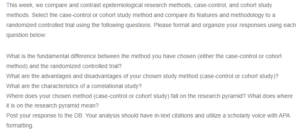Epidemiological Methods and Measurements
Difference between cohort study method and randomized controlled trial (RCT)
The primary distinction between a cohort study and an RCT is whether or not the investigator employs randomization to assign patients to the control and treatment groups. Participants in an RCT are assigned randomly to get the treatment or not, while participants in a cohort study are naturally split into the control and treatment groups (Sharma, 2018). The researcher has no control over who receives therapy and who does not.
Do you need help with your assignment ? Contact us.
Advantages and disadvantages of cohort study method
Advantages include One can directly calculate incidence and calculate the relative risk, more than one risk factor result is possible can be evaluated, the dose-response connection with exposure can be researched, there is a temporal relationship between the exposure and the result and various biases like recollection bias, interviewer’s prejudice is not a concern (Sharma, 2018). The main disadvantage is the enormous need for resources, i.e., time, resources, and people. Other disadvantages include being inappropriate for uncommon diseases, long-term follow-up being required as long as follow-up is necessary, and attrition being an issue. The study of risk variables is limited to one or a few (Sharma, 2018).
Characteristics of a correlational study
A correlational study is a non-experimental study where a researcher evaluates two variables, analyzes the statistical association between them, and makes conclusions without the help of any additional factors. It is non-experimental, meaning the variables are neither changed nor subjected to extrinsic conditioning; the researcher merely measures and examines the connection between the variables. It is backward-looking because it considers historical information and keeps track of previous events; researchers estimate and use it to identify historical trends between two variables (Grove & Gray, 2018). It is dynamic because the correlational patterns between two factors are never static and are continually shifting.
Cohort study method-research pyramid
A cohort study, unfiltered evidence, is at the pyramid base. This is the primary literature, also called individual publication and analysis; hence, it is a level IV evidence research study. Location on the research pyramid means its level of evidence represented by a pyramid model demonstrating the quantity and quality of existing evidence. The strength of the evidence increases with the group on the pyramid (Le Goues et al., 2018). Evidence pyramids are frequently separated into two parts. Filtered (secondary) research, such as meta-analyses, systematic reviews, and critical evaluations, is presented in the top part. Unfiltered (primary) research, such as cohort studies, randomized controlled trials, and case studies, is included in the base.
References
Grove, S. K., & Gray, J. R. (2018). Understanding nursing research e-book: Building an evidence-based practice. Elsevier Health Sciences.
Le Goues, C., Jaspan, C., Ozkaya, I., Shaw, M., & Stolee, K. T. (2018). Bridging the gap: From research to practical advice. IEEE Software, 35(5), 50-57.
Sharma, S. (2018). Nursing research and statistics. Elsevier Health Sciences.
ORDER A PLAGIARISM-FREE PAPER HERE
We’ll write everything from scratch
Question
This week, we compare and contrast epidemiological research methods, case-control, and cohort study methods. Select the case-control or cohort study method and compare its features and methodology to a randomized controlled trial using the following questions. Please format and organize your responses using each question below:

Epidemiological Methods and Measurements
What is the fundamental difference between the method you have chosen (either the case-control or cohort method) and the randomized controlled trial?
What are the advantages and disadvantages of your chosen study method (case-control or cohort study)?
What are the characteristics of a correlational study?
Where does your chosen method (case-control or cohort study) fall on the research pyramid? What does where it is on the research pyramid mean?
Post your response to the DB. Your analysis should have in-text citations and utilize a scholarly voice with APA formatting.

